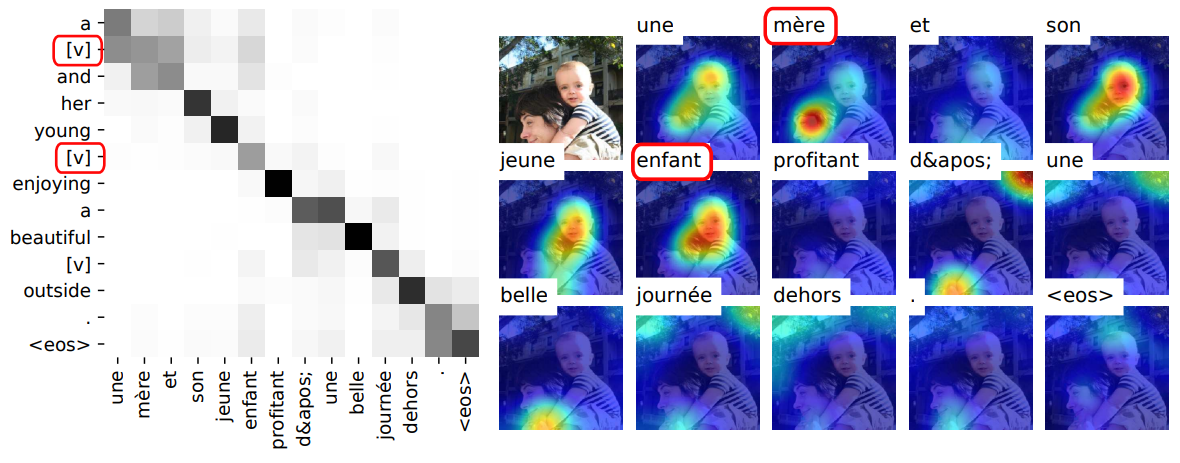Machine Translation Weekly 6: Probing the Need for Visual Context in Multimodal Machine Translation
This week, we will have a look at a paper that won the best short paper award at NAACL 2019. The name of the paper is Probing the Need for Visual Context in Multimodal Machine Translation and it was written by friends of mine from Le Mans University and Imperial College of London.
The paper is concerned with multimodal machine translation. It is a task of translating image captions when having access both to the sentence in the source language and the image itself. Multimodal translation first appeared as a shared task at WMT 2016 and was repeated in 2017 and 2018. (Our—Charles University team participated in all three rounds and multimodal translation became the topic of my Ph.D. thesis.) During the three years of the competition, many interesting techniques for multimodal representation fusion were developed. However, the gains in translation quality were always modest and it was never completely clear if the translation quality difference is caused by the multimodal capabilities of the models or by some random artifacts. Whereas in 2017, the manual evaluation at WMT suggested that multimodal models are better than their text-only counterparts, in 2018 when the translation quality was higher in general (thanks to the Transformer models), there was basically no difference between the text-only and multimodal models.
The translation quality, however, is not the only thing that people solving the task are interested in. The main research question behind the task is how to design deep learning models to be able to consider textual and visual information simultaneously. It was never evident from the translation quality whether it happens or not, but the introspection of the attention in the models suggested that the models indeed take advantage of both modalities.
This paper finally brings a clear quantitative answer to this question. It introduces a method that fully shows the capabilities of the models for multimodal translation using a simple but clever idea. The authors conducted experiments with artificial noise in the source sentences and measured how well the missing information from the source sentences can be recovered when different model architectures are used. In particular, they were masking out (think of BERT, masking out words is obviously popular these days) following words:
-
color adjectives;
-
nouns denoting entities in the image; and
-
words from the end of the sentence.
In all the experiments, multimodal models (with only small differences among the multimodal architectures) were able to recover the missing information using the image, in contrast to the text-only models that do not any other option than guessing the missing word using the textual context.
The most interesting result of the paper is that masking the words during training also makes the attention over the image much more aware of the objects in the picture as can be seen in the following visualization.

Isn’t it fascinating? Anyway, congratulations to the authors for the fully deserved best paper award!
BibTeX Reference
@inproceedings{caglayan2019probing,
title = "Probing the Need for Visual Context in Multimodal Machine Translation",
author = {Caglayan, Ozan and
Madhyastha, Pranava and
Specia, Lucia and
Barrault, Lo{\"\i}c},
booktitle = "Proceedings of the 2019 Conference of the North {A}merican Chapter of the Association for Computational Linguistics: Human Language Technologies, Volume 1 (Long and Short Papers)",
month = jun,
year = "2019",
address = "Minneapolis, Minnesota",
publisher = "Association for Computational Linguistics",
url = "https://www.aclweb.org/anthology/N19-1422",
doi = "10.18653/v1/N19-1422",
pages = "4159--4170",
}
Share the post
@misc{libovicky2019blog0611,
author = "Jindřich Libovický",
title = "Jindřich's Blog -- Machine Translation Weekly 6: Probing the Need for Visual Context in Multimodal Machine Translation",
year = "2019",
month = jun,
url = "https://jlibovicky.github.io/2019/06/11/MT-Weekly-Probing-the-need-for-visual-context",
note = "Online, Accessed: 02.04. 2025"
}